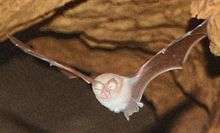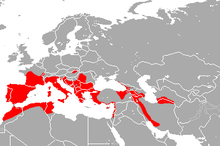Mediterranean horseshoe bat
| Mediterranean horseshoe bat | |
|---|---|
 | |
| Scientific classification | |
| Kingdom: | Animalia |
| Phylum: | Chordata |
| Class: | Mammalia |
| Order: | Chiroptera |
| Family: | Rhinolophidae |
| Genus: | Rhinolophus |
| Species: | R. euryale |
| Binomial name | |
| Rhinolophus euryale Blasius, 1853 | |
 | |
| Mediterranean horseshoe bat range | |
The Mediterranean horseshoe bat (Rhinolophus euryale) is a species of bat in the family Rhinolophidae. It is found in the Mediterranean region and balkan peninsula, as well as parts of Italy.
Physical characteristics
The head and body are normally between 43 and 58 mm, with a 22–30 mm tail. The wingspan of R. euryale is between 300 and 320 mm, with a standard weight between 8 and 17.5 grams. The upper connecting process is pointed and slightly bent downwards, and is distinctly longer than the lower connecting process, which is broadly rounded when seen from below.
The fur is fluffy, with a light grey base. The dorsal side is grey-brown, with sometimes a slight reddish tinge, while the ventral side is grey-white or yellow-white.[1]
Habitat
R. euryale tends to live in warm, wooded areas in foothills and mountains, preferring limestone areas with numerous caves and nearby water. Summar roosts and nurseries are in caves, although sometimes in warm attics in the north. Roosts are frequently shared with other horseshoe bat species, although without any kind of intermingling.
Reproduction
There is little known information about the Mediterranean horseshoe bat's reproductive cycle. Nurseries normally hold between 50 and 400 females, with males sometimes present.
Hunting
Mediterranean horseshoe bats leave their roosts in late dusk, hunting low over the ground on warm hillsides but also in relatively dense tree cover, preying on moths and other small insects.
References
- Chiroptera Specialist Group 1996. Rhinolophus euryale. 2006 IUCN Red List of Threatened Species. Downloaded on 30 July 2007.
- Schober, Wilfried; Eckard Grimmberger (1989). Dr. Robert E. Stebbings, ed. A Guide to Bats of Britain and Europe (1st ed.). UK: Hamlyn Publishing Group. ISBN 0-600-56424-X.
